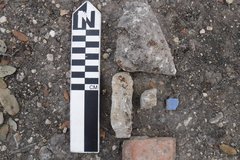Very little ground-disturbance occurred during week 15 of the Mission Gate and Lunette Project. Archaeologists monitored the excavation of utility trenches that extended approximately 18 inches below surface (Figure 1). The shallow trenches were approximately 12 to 18 inches in width. These trenches were for the installation of electric lines and were along tree planters and the exhibit construction (Figure 2).
Mission Gate and Lunette Archaeology - March 13


Much of the Project Area was previously graded to a deeper extent during the removal of the large live oak and then raised up again using the same soils. As a result, the soils were heavily mixed. Some artifacts were observed during the excavations, all were observed in the modern construction fill soils. After the installation of conduits, the trenches were backfilled with the same soils.
In addition to utility trenching, archaeologists monitored the removal of soil around the existing trees. While much of this soil removal was above-surface within the tree planters, there was minimal grading surrounding the planters. The planter walls were straightened via air-spading. This technique was only used on the above surface planter soils (Figure 3). Air-spading removes soils with minimal damage to tree roots, which is why it was selected for the planter soils surrounding the trees. Once the planter soils were cleaned up, a flat blade mini excavator scraped the surface at the base of the planter (Figure 4). This grading extended no more than 4 inches below surface. There was no cultural material observed during activities in and around the tree planters (Figure 5).





